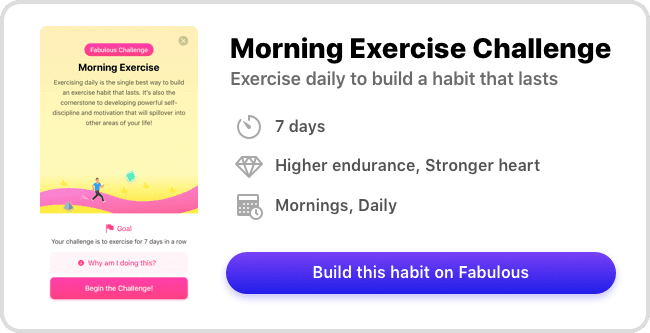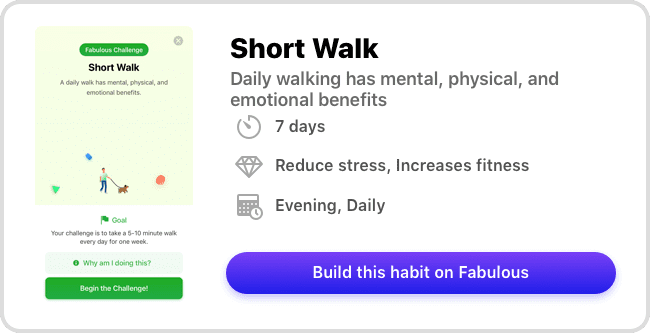Always stressed, and don’t know how to stay calm? If you’ve ever used any of the Fabulous app’s “Make Me Fabulous!” modules, you might recognize these instructions:
Take a deep breath. Inhale for five seconds, sustain for three seconds, and exhale for seven seconds.
This slow breathing technique activates your parasympathetic nervous system, which is dedicated to relaxing your body, slowing your heart rate, and calming you down.
Stress from time to time is normal and even good for us, but prolonged stress can wreak serious havoc on the body and mind if steps aren’t taken to manage it.
With the holiday season approaching—and bringing with it even more stress and chaos into our lives—learning how to stay calm during intense situations can help make even the most disastrous December feel like a happy holiday season. Meditation is the one of the most effective ways to soothe your mind and recenter your thoughts when life starts to get out of hand.
How to stay calm in 5 different ways:
1. We can train ourselves to relax.
Like Aristotle said, we are what we repeatedly do. Worrying often feels like second nature because we have “practiced” worrying repeatedly for years. We worry about everything, and we do it constantly because we’re constantly being reminded of the things that worry us. It’s hard not to think about work, for example, when you keep getting emails from work on your phone!
We take fewer vacations than generations before us, work longer hours, sleep less, and eat worse, effectively setting ourselves up for burnout.
The good news is that relaxing is a skill just like worrying, and regular practice over time can make lowering our stress levels just as easy as raising them. Finding what specific relaxation techniques work best for you will take some trial and error, but there are some universal things to keep in mind while on your journey to tranquility:
2. Know thy symptoms.
Everybody responds to stress in different ways. Some people (like me) grind their teeth, while others might cry or become angry and lash out at others. Being able to recognize what stress looks and feels like for you will make you better-equipped to deal with your emotions before they spiral out of control.
3. Practice relaxation techniques before you need them.
When you’re in a high-stress situation it can be impossible to think. So it’s important to already have some relaxation tricks up your sleeve before that happens. Practicing when you’re already calm can help you better recognize what works for you and what doesn’t while also giving you the experience necessary to tap into those skills when you do need them.
4. Slow and steady wins the race.
No one becomes an expert in anything overnight. Don’t beat yourself up for mistakes or worry about getting everything perfectly right from the beginning. After all, you’re supposed to be worrying less, not more! Give yourself space and time to adjust; like any other bad habit, quitting stress cold turkey can cause withdrawal symptoms like mood swings and changes in energy levels.
5. Find what relaxation techniques work best for you to build a self-care habit that sticks.
Just like stress is different for everyone, so too is relaxation. For some, it’s as easy as visualizing a calming beach or zoning out in front of the TV. But for others, relaxing requires more physical or mental stimulation, such as solving crossword puzzles or building birdhouses.
Below are some relaxation techniques to help you get started on your journey. You can do these just about anywhere with little-to-no experience or equipment.
Morning Exercise. Not only is exercise good for your body, but it’s also great for your mind! Working up a sweat releases endorphins in your body, which help you feel happy and calm. Plus, it’s hard to be stressed when you’re tired from a good workout!
Deep breathing. Any deep breathing that involves exhaling longer than you inhale will activate your body’s relaxation response. The best part is you can do it anywhere for as long as you need to calm down.
Progressive muscle relaxation. Progressive muscle relaxation involves focusing on flexing certain muscle groups in your body as tightly as you can before relaxing them. Not only does it help you relax, but it identifies what parts of your body hold the most tension. Consult with a health professional if you have a history of muscle spasms, back pain, or any other medical concern that may be aggravated by tensing muscles.
Meditation. Mindfulness and meditation have been spreading like wildfire across the western world as a cheap and easy way to manage stress. The Fabulous app has several meditation modules that can help you get started.
Let’s try putting one of these relaxation techniques to the test, and start with the simple exercise of a short walk. Challenge yourself to go for a 10min walk for the next week. You don’t have to plan a route, just explore a new area each day and let your mind observe the beauty around. Put this challenge into practice and learn how to stay calm and relaxed in your everyday life.






